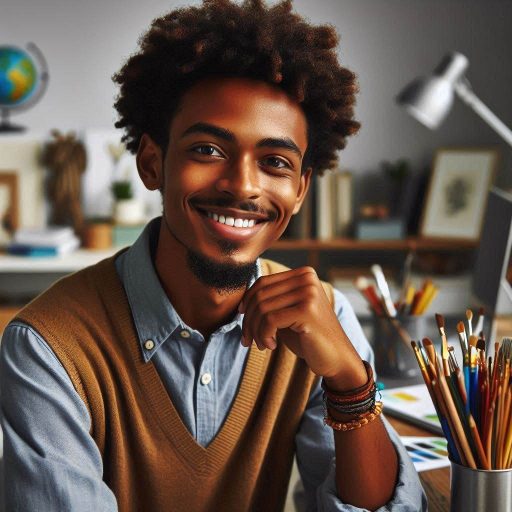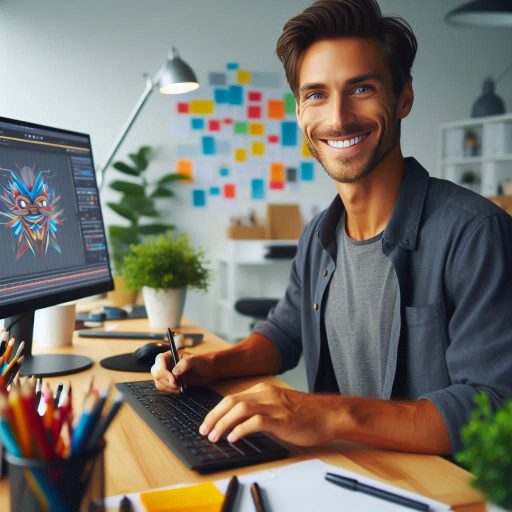Introduction
Digital art refers to artistic works that rely on digital technology for their creation and presentation.
It has become increasingly popular in today’s society due to its accessibility and versatility.
Digital art allows artists to explore new forms of expression and reach a wider audience through online platforms.
It also provides opportunities for collaboration and experimentation.
Preview of the Future
- Advancements in Technology: Future of digital art will be shaped by advancements in technology such as virtual reality and artificial intelligence.
- Increased Accessibility: Digital art tools will become more user-friendly and affordable, allowing more people to participate in creating and consuming digital art.
- Integration of Traditional and Digital: Artists will continue to blend traditional art techniques with digital tools to create unique and innovative works.
- Rise of NFTs: Non-fungible tokens (NFTs) are transforming the digital art market, offering new ways for artists to monetize their creations and establish ownership.
- Impact on Society: Digital art will play a significant role in shaping cultural conversations and challenging traditional notions of art and creativity.
The future of digital art holds immense potential for creativity, collaboration, and innovation.
As technology continues to evolve, digital art will remain at the forefront of artistic expression in the years to come.
Technological advancements
Emerging technologies that will impact the digital art world
Technology is rapidly evolving, and this evolution is significantly impacting the world of digital art.
One of the emerging technologies that will have a profound impact on digital art is artificial intelligence (AI).
AI has the potential to revolutionize the way artists create and interact with digital art.
From generating artwork to helping artists streamline their creative process, AI is set to play a crucial role in the future of digital art.
Additionally, virtual reality (VR) and augmented reality (AR) are also emerging technologies that will shape the digital art landscape.
These technologies allow artists to create immersive experiences for viewers, blurring the lines between the physical and digital worlds.
Artists can use VR and AR to transport viewers to virtual galleries or interactive art installations, opening up new possibilities for creative expression.
Moreover, blockchain technology is poised to transform the art industry, including digital art.
By using blockchain, artists can authenticate their work, protect their intellectual property rights, and ensure transparency in transactions.
This technology has the potential to revolutionize the way digital art is bought, sold, and collected, making it more accessible and secure for artists and buyers alike.
Examples of how technology is already shaping digital art
Technology has already made a significant impact on digital art, changing the way artists create and audiences engage with art.
One notable example is the use of digital tools and software in the creation process.
Artists can now create intricate digital artworks using software like Adobe Photoshop, Procreate, and Blender, among others.
These tools offer a wide range of capabilities, allowing artists to experiment with different styles and techniques easily.
Transform Your Career Today
Unlock a personalized career strategy that drives real results. Get tailored advice and a roadmap designed just for you.
Start NowAnother example of technology shaping digital art is the rise of NFTs (non-fungible tokens) in the art world.
NFTs are unique digital tokens that represent ownership of a specific artwork or collectible item.
Artists can mint their digital art as NFTs, enabling them to sell and authenticate their work on blockchain platforms like Ethereum.
This technology has created new opportunities for artists to monetize their digital creations and reach a global audience of collectors.
Additionally, social media platforms have become essential tools for artists to showcase and promote their digital art.
Platforms like Instagram, Behance, and ArtStation allow artists to share their work with a vast online audience, connecting with fellow artists, collectors, and art enthusiasts.
Social media has democratized the art world, enabling artists to gain recognition and build a following without the need for traditional galleries or institutions.
Predictions on how technology will continue to influence digital art in the future
Looking ahead, it is clear that technology will continue to play a pivotal role in shaping the future of digital art.
One prediction is that advancements in AI will empower artists to explore new creative possibilities.
AI-powered tools can assist artists in generating complex visuals, enhancing their artistic skills, and even collaborating with AI systems to co-create artworks.
This fusion of human creativity and artificial intelligence has the potential to push the boundaries of digital art and redefine what is possible in the art world.
Furthermore, the integration of AR and VR technologies is expected to revolutionize the way audiences experience and interact with digital art.
Artists will be able to create immersive, interactive artworks that engage viewers on multiple sensory levels, blurring the lines between virtual and physical reality.
This fusion of art and technology will create entirely new art forms and experiences, transforming the way we perceive and appreciate art in the digital age.
Additionally, blockchain technology will continue to disrupt the art industry, offering artists new avenues for monetization, authentication, and distribution of their digital art.
NFTs will become more mainstream, providing artists with a secure platform to sell their digital creations directly to collectors worldwide.
Blockchain boosts transparency and traceability in the art market.
It ensures fair compensation for artists. Buyers can verify digital artwork authenticity.
In fact, the future of digital art is intertwined with technological advancements that are reshaping the way artists create, share, and monetize their work.
As emerging technologies like AI, VR, AR, and blockchain continue to evolve, the possibilities for digital art are limitless.
Transform Your Career Today
Unlock a personalized career strategy that drives real results. Get tailored advice and a roadmap designed just for you.
Start NowArtists and audiences alike can look forward to a future where creativity knows no bounds, and innovation drives the art world forward into uncharted territory.
Read: Managing Time as a Freelance Digital Artist
Evolution of Digital Tools
In the world of computer-generated art, technology plays a crucial role in shaping the way artists create and express themselves.
From software programs to specialized hardware, digital tools have evolved significantly over the years.
Overview of Current Digital Tools Used by Artists
- Graphic Design Software: Programs like Adobe Photoshop and Illustrator are staples for digital artists, allowing for intricate designs and edits.
- 3D Modeling Tools: Software such as Blender and Autodesk Maya enable artists to create detailed 3D models and animations.
- Digital Drawing Tablets: Devices like Wacom tablets provide a natural drawing experience for artists, mimicking traditional pen and paper.
- Virtual Reality Tools: VR technology opens up new possibilities for immersive art experiences, allowing artists to create in a virtual environment.
- Artificial Intelligence: AI-powered tools like style transfer algorithms can generate unique art pieces based on existing styles and patterns.
Potential New Tools that Could Revolutionize Digital Art
As technology continues to advance, there are several new tools on the horizon that could revolutionize the digital art landscape.
- Augmented Reality: AR technology could offer new ways for artists to interact with their creations in the real world, blurring the lines between physical and digital art.
- Blockchain for Digital Art: The use of blockchain technology for computer-generated art authentication and ownership could provide a secure and transparent way to buy and sell artwork online.
- Generative Adversarial Networks (GANs): GANs have the potential to create realistic and unique images, opening up new avenues for digital artists to explore.
- 3D Printing: Advancements in 3D printing technology could enable artists to bring their digital creations into the physical world with ease.
- Neural Interfaces: Neural interfaces could allow artists to create art using only their thoughts, opening up a whole new realm of possibilities for expression.
How These Tools Will Enhance the Creative Process and Output of Digital Artists
By incorporating these new tools into their workflow, digital artists stand to benefit in several ways, enhancing both their creative process and the quality of their output.
- Increased Efficiency: New tools can streamline the artistic process, saving time and allowing artists to focus more on creating.
- Expanded Possibilities: With access to a wider range of tools, artists can experiment with new techniques and styles, pushing the boundaries of their creativity.
- Enhanced Collaboration: Tools like virtual reality and blockchain can facilitate collaboration among artists, leading to the creation of unique and innovative art projects.
- Improved Quality: Advanced tools like AI algorithms and 3D printing can enhance the quality of digital art by providing more realistic and detailed results.
- Greater Accessibility: As digital tools become more user-friendly and affordable, artists from diverse backgrounds can access these technologies and unleash their creative potential.
Read: How to Balance Detail and Simplicity in Characters

The rise of virtual reality and augmented reality
Virtual reality (VR) and augmented reality (AR) have been making significant waves in the world of computer-generated art.
These technologies offer artists new ways to create and experience art, pushing the boundaries of what is possible in the digital realm.
How VR and AR are already being used in digital art
VR allows artists to immerse viewers in a completely digital environment, creating a sense of presence and interactivity.
AR overlays digital content onto the real world, merging physical and virtual elements in a seamless way.
Many artists have already started experimenting with VR and AR, creating mind-bending experiences that blur the lines between reality and the digital realm.
How VR and AR will become more prevalent in the future
As VR and AR technology becomes more accessible and affordable, we can expect to see a surge in the use of these technologies in computer-generated art.
Artists will continue to push the boundaries of what is possible with VR and AR, exploring new ways to engage with audiences and create immersive experiences.
VR and AR have the potential to revolutionize the way we experience art, offering new perspectives and dimensions that were previously unimaginable.
How artists are pushing boundaries with VR and AR technology in their work
Some artists are creating interactive VR installations that allow viewers to move through and interact with digital environments in real-time.
Others are using AR to bring their artwork to life, overlaying animations and digital effects onto physical objects or spaces.
Collaborations between artists and technologists are leading to groundbreaking projects that combine cutting-edge technology with artistic vision.
In short, the future of computer-generated art looks bright with the rise of virtual reality and augmented reality.
These technologies offer endless possibilities for artists to create immersive and interactive experiences that push the boundaries of art and technology.
Transform Your Career Today
Unlock a personalized career strategy that drives real results. Get tailored advice and a roadmap designed just for you.
Start NowAs VR and AR evolve, artists explore new digital realms.
We anticipate groundbreaking work as these technologies advance.
The digital realm offers limitless potential for innovative art.
Read: How to Stay Inspired as a Digital Artist
Impact on traditional art forms
Digital art has significantly impacted traditional art forms by offering a new medium for artists to express their creativity.
Comparison between digital art and traditional art forms
In terms of comparison, computer-generated art allows for a more dynamic and versatile approach compared to traditional methods.
It offers endless possibilities in terms of colors, textures, and effects that can be easily manipulated with the use of software tools.
Traditional art forms, like painting and sculpture, feel tactile.
They evoke nostalgia and authenticity. Digital art often lacks these qualities.
How digital art is changing the way we perceive and create art
The rise of computer-generated art has also changed the way we perceive and create art.
With the advancements in technology, artists are now able to experiment with new techniques and styles that were previously impossible with traditional methods.
Digital art fosters collaboration and sharing on online platforms.
Artists reach wider audiences through social media. They gain more recognition for their work.
How digital art will continue to influence and blend with traditional art forms in the future
Looking towards the future, it is predicted that computer-generated art will continue to influence and blend with traditional art forms.
We can expect to see more hybrid approaches that combine elements of both digital and traditional methods to create innovative and unique artworks.
As technology continues to evolve, artists will have access to even more advanced tools and techniques that will further blur the lines between digital and traditional art forms.
In general, the future of computer-generated art is bright, and it will continue to reshape the art world by offering new possibilities and pushing the boundaries of creativity.
As digital art continues to grow and develop, it will undoubtedly have a lasting impact on traditional art forms and the way we perceive and create art.
Read: Effective Use of Shapes in Character Design
Accessibility and democratization of art
How digital art has made art more accessible to a wider audience
Digital art has transformed the art world, making it more accessible to a wider audience than ever before.
Transform Your Career Today
Unlock a personalized career strategy that drives real results. Get tailored advice and a roadmap designed just for you.
Start NowIn the past, art galleries and museums were the primary venues for viewing and appreciating art.
However, with the rise of computer-generated art, people can now access a diverse range of artwork from the comfort of their own homes.
Artists now showcase work globally through enhanced accessibility.
This breaks traditional barriers in the art world.
How platforms like social media have democratized the art world
Social media platforms have played a crucial role in democratizing the art world.
Artists can now reach a vast audience through platforms like Instagram, Facebook, and Twitter, eliminating the need for gallery representation.
This direct connection between artist and audience has empowered artists to share their work, gain recognition, and build a loyal following.
It has also enabled art enthusiasts to discover new artists and engage with art in a more interactive and personal way.
How the future of digital art will further break down barriers to entry for aspiring artists
Looking ahead, the future of computer-generated art holds great promise for aspiring artists.
With advancements in technology, tools for creating and sharing art will become more accessible and user-friendly.
As a result, artists will have greater opportunities to express themselves creatively and connect with a global audience.
Additionally, emerging digital platforms and online communities will provide avenues for artists to collaborate, learn, and grow their skills.
Overall, the future of computer-generated art is bright, offering a more inclusive and diverse landscape for artists of all backgrounds to thrive.
Ethical considerations
Copyright issues and plagiarism in the digital art world
When it comes to digital art, ethical considerations play a crucial role in shaping the landscape of this creative field.
One of the key issues that artists and creators face is the challenge of copyright infringement and plagiarism.
Digital art is easily replicable and shareable online, making it vulnerable to unauthorized use and reproduction.
Artists face crucial questions on protecting their work.
They must ensure proper credit for their creations. They need fair compensation for their artistic efforts.
How digital art challenges traditional notions of authorship and ownership
With the rise of computer-generated art, traditional notions of authorship and ownership are being challenged.
In the digital realm, collaborations across different artists and mediums are becoming more common, blurring the lines of individual authorship.
Transform Your Career Today
Unlock a personalized career strategy that drives real results. Get tailored advice and a roadmap designed just for you.
Start NowDigital art’s ease of modification and remixing creates ownership issues.
It also raises questions about credit for collaborators.
Who owns the final work? How should we give credit?
How ethical considerations will shape the future of digital art and its reception
As computer-generated art continues to evolve, it is essential to consider how ethical considerations will shape its future.
Artists and creators will need to navigate complex questions about ownership, authorship, and attribution in a rapidly changing digital landscape.
One prediction is that ethical considerations will play an increasingly important role in how computer-generated art is perceived and received by audiences.
As awareness grows, people will credit artists more.
They will respect intellectual property rights. This shift will foster ethical practices in digital art.
Art platforms and galleries will enforce stricter copyright guidelines.
This will help artists protect their work effectively.
Artists will gain control over their work’s use. They will manage how their work is shared online.
Ethical considerations will shape the future of computer-generated art.
They will affect how artists create and share their work.
They will also influence how audiences engage with digital art.
These factors will impact the appreciation of digital art in the future.
You Might Also Like: Museum Curator Salary: What You Can Expect to Earn
Collaboration and Community
In the world of computer-generated art, collaboration has become a key component in fostering creativity and innovation.
Artists now connect globally, breaking traditional barriers.
They introduce new perspectives into the creative process.
Overview of how digital art has fostered collaboration among artists
Digital platforms like social media and online forums connect artists.
Transform Your Career Today
Unlock a personalized career strategy that drives real results. Get tailored advice and a roadmap designed just for you.
Start NowArtists collaborate, share ideas, and learn from each other.
Artists now merge styles and techniques to create unique works.
This cross-pollination in art has reached unprecedented levels.
How online communities have shaped the digital art scene
Online communities shape the computer-generated art scene.
Artists showcase their work on these platforms.
They receive feedback from peers and experts. Networking opportunities abound with other creatives.
These interactions drive growth and innovation in computer-generated art.
These communities have also served as a support system for emerging artists, offering mentorship and guidance as they navigate the art world.
Platforms like DeviantArt, Behance, and ArtStation have become hubs for digital artists to connect, collaborate, and find inspiration.
Artists can join groups, participate in challenges, and engage in discussions that help them grow and evolve as creatives.
How collaborative efforts and community building will continue to shape the future of digital art
As technology advances and connectivity grows, collaboration in digital art increases.
Artists will leverage new tools for greater community building.
Future computer-generated art will thrive on enhanced collaborative efforts.
Artists collaborate in real-time, crossing borders and time zones.
They create innovative and groundbreaking works together.
Virtual reality and augmented reality offer new collaboration avenues.
Artists can interact more directly with their audiences.
They will create immersive, engaging art experiences.
Online marketplaces and digital galleries will also create new opportunities for artists to share their work and reach a global audience.
In the future, computer-generated art will thrive on collaboration.
Transform Your Career Today
Unlock a personalized career strategy that drives real results. Get tailored advice and a roadmap designed just for you.
Start NowArtists will actively build communities to enhance creativity.
They will shape how we create and share art.
Digital art experiences will evolve through active community engagement.
As artists continue to connect and collaborate, we can expect to see new forms of art emerge, pushing the boundaries of creativity and innovation.
Conclusion
The future of computer-generated art is filled with endless possibilities and innovations.
From the use of AI and VR to new mediums and platforms, the art world is evolving rapidly.
It is important for artists and enthusiasts to stay informed about these changes.
By embracing these advancements, we can unlock the full potential of digital art.
Together, we can shape a future where creativity knows no bounds.
Let’s continue to explore, experiment, and push the boundaries of digital art.
Remember to keep an open mind and stay engaged with the evolving landscape of digital art.
Exciting times lie ahead, and we have the power to transform the world through digital art.
Join us on this journey as we redefine art in the digital age!




